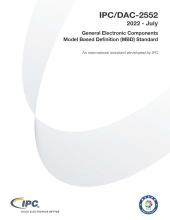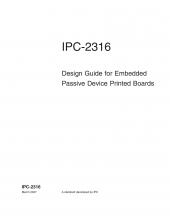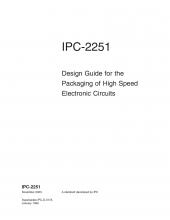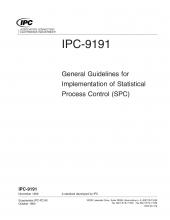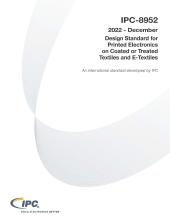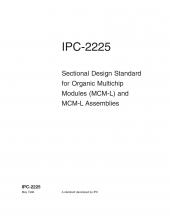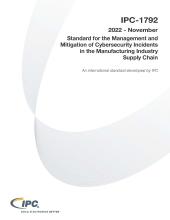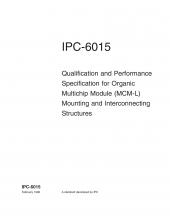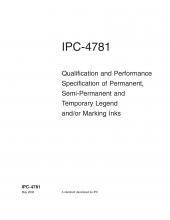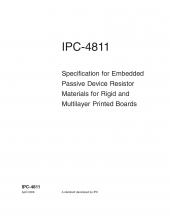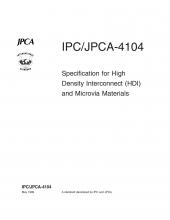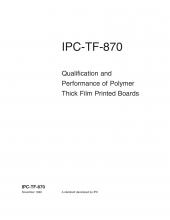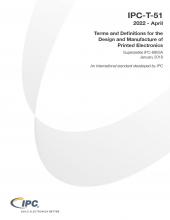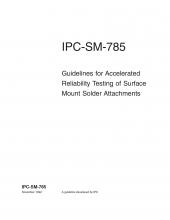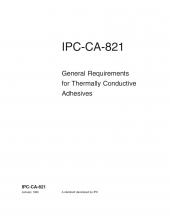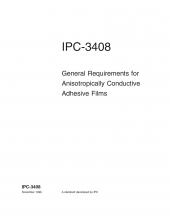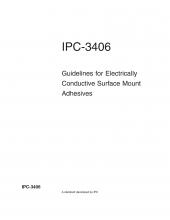This standard establishes construction detail requirements for bumps and other terminal structures used for Flip Chip Scale carriers. The specific standards for different terminations are appropriately matched to a particular interconnection process and include such diverse terminations as solder bumps, columns, non-melting stand-offs and conductive polymer deposits. The document articulates a set...
Your results
- 921
Document #
Language
Products
This standard specifies the XML schema that represents the intelligent data file format used to describe printed board fabrication data description. This format may be used for transmitting information between a printed board designer and a manufacturing or assembly facility. The data is most useful when the manufacturing cycle includes computer-aided processes and numerical control machines. The...
This standard specifies the XML schema that represents the intelligent data file format used to describe administration information related to ordering and specifying printed boards, printed board assemblies, fixtures, and components. The format is a convergence of the Valor Computerized Systems ODB++ and IPC-2511B GenCAM® format structure in XML schema. IPC-2581 is a mandatory part of this...
This standard specifies the XML schema that represents the intelligent data file format used to describe administration information related to ordering and specifying printed boards, printed board assemblies, fixtures, and components. The format is a convergence of the Valor Computerized Systems ODB++ and IPC-2511B GenCAM® format structure in XML schema. IPC-2581 is a mandatory part of this...
The IPC/DAC-2552 standard was developed jointly with the Digital Association of China (DAC), with the purpose to use Model Based Definition (MBD) to realize efficient and high-quality digital design of board-level assembly, support electronic assembly virtual manufacturing, and enabling the digitalization from requirement to product realization for printed board assemblies. The IPC/DAC-2552...
Establishes mechanical drop and shock and test guidelines for assessing solder joint reliability of printed board assemblies from system to component level. This document addresses methods to define mechanical shock use-conditions, methods to define system level, system printed board level and component test board level testing that correlate to such use conditions and guidance on the use of...
IPC-2316 offers printed board users and designers the necessary information for incorporating formed and placed embedded passive components into their applications. The history of embedded passive technologies is given along with full coverage of embedded resistors, capacitors and inductors. In addition, it also assists the user in understanding some of the physical, electrical and thermal...
This guideline addresses the major factors influencing the design of high-speed circuitry. Considerations include electrical noise, electromagnetic interference, signal propagation time, impedance, thermo-mechanical environmental protection, and heat dissipation. Supersedes IPC-D-317A. Key improvements over the IPC-D-317A document include updated impedance models for embedded microstrip, centered...
IPC-9191 reflects the principals of statistical process control (SPC) represented by ISO/DIS 11462-1, Guidelines for Implementation of Statistical Process Control (SPC) -- Part 1: Elements of SPC. This document outlines the SPC philosophy, implementation strategies, tools, and techniques used for relating process control and capability to final product requirements. Supersedes IPC-PC-90.
IPC-8952 standard establishes specific requirements for the design of printed electronic applications and their forms of component mounting and interconnecting structures on coated or treated textile substrates. Textile substrate, as pertains to IPC-8952 standard, could be a bare textile or an integrated e-textile (e.g., woven or knitted e-textile). Coated or treated textile substrates, as pertain...
Used in conjunction with IPC-2221A, IPC-2225 establishes the requirements and other considerations (thermal, electrical, electromechanical and mechanical) for the design of Single Chip Module (SCM-L), MCM or MCM-L assemblies. Key concepts include adhesive interconnection information, typical die attach materials, microvia material properties and relationships with DFM and DFE. 44 pages. Released...
IPC-1792 standard establishes requirements for companies to provide assurance that their products have been manufactured in cybersecure environments, ensuring that there has been no risk of impact to the product due to any cybersecurity incident. IPC-1792 requirements specify actions that need to be taken if a cybersecurity incident is detected, identifying all possible affected products.
The IPC-6902 standard establishes and defines the qualification and performance requirements for printed electronics and the forms of component mounting and interconnecting structures on flexible substrates.
Establishes the specific requirements for organic mounting structures used to interconnect chip components, which in combination form the completed functional organic single-chip module (SCM-L) or organic multichip module (MCM-L) assembly. Includes the quality and reliability assurance requirements that must be met for their acquisition. For use with IPC-6011. 25 pages. Released February 1998.
The industry's first specification for the evaluation of a legend and/or marking ink material for the determination of acceptability of use in a standard printed board system. IPC-4781 provides coverage for adhesion, material qualification and testing, resistances to solvents, requirements for resistance to lead-free solders, and electrical requirements. 17 pages. Released May 2008.
The IPC-4555 standard covers the requirements and testing for organic solderability preservatives (OSP) processes for printed boards to be used primarily for electrical and electronic circuits. Details for lead free soldering are covered in IPC-4555
This document describes materials that can be used for the fabrication of embedded passive resistor devices within the finished printed circuit board substrate. It provides information on general designations and associated characteristics of embedded passive device (EPD) resistor materials. The document shall be used as a qualification and conformance standard for designers and users when...
Covers the various conductive and dielectric materials that can be used for the fabrication of HDI and microvias. The 23 specification sheets included in IPC/JPCA-4104 cover the qualification and conformance requirements for such materials as photoimageable dielectric dry films and liquids, epoxy blends and coated foils. IPC/JPCA-4104 also includes six new test methods developed specifically for...
Covers the materials, qualification, certification and performance requirements for multilayer polymer thick film (PTF) printed, extrusion deposited, or otherwise applied conductor, insulator and through-hole technology. This specification may also be used for procurement of single and double-sided boards. 59 pages. Released November 1989.
IPC-T-51 standard provides terms and definitions for the design and manufacture of printed electronics. IPC-T-51 standard enables common language and understanding for the worldwide printed electronics community.
Guidelines for accelerated reliability testing of surface mount solder attachments when evaluating and extrapolating the results of these tests towards actual use environments of electronic assemblies. 50 pages. Released November 1992.
Covers requirements and test methods for thermally conductive dielectric adhesives used to bond components in place. Permanent, removable and self-shimming adhesives are addressed. 18 pages. Released January 1995.
This document covers requirements and test methods for anisotropically conductive adhesive films used to bond and electrically connect components. Applications include the following: flexible PWB-to-glass, flexible PWB-to-rigid PWB, flip chip-to-glass, flip chip-to-flexible PWB, flip chip-to-rigid PWB, and fine pitch SMD. The adhesive film may be supplied pre-attached to a flexible circuit or...
IPC-3406 offers guidelines for selecting electrically conductive adhesives for use in electronics manufacturing as solder alternatives. The process discussion attempts to stay within the bounds of the existing solder assembly infrastructure. Both major types of adhesives, isotropic (conducting equally in all directions) and anisotropic (unidirectional conductivity) are covered. Polymer adhesives...
This standard establishes the requirements for the documentation of printed circuit board fabrication, and identifies the physical attributes and performance requirements of the unpopulated product. The descriptions apply to rigid, flexible, inorganic substrates or any combination thereof. The construction may be single, double, multilayered, or HDI technology and may include embedded (integrated)...
Coming Soon
IPC-7095E: Design and Assembly Process Implementation for Ball Grid Arrays (BGAs)
J-STD-005B: Requirements for Soldering Pastes
IPC-4105: Specification for Metal Base Copper Clad laminates for Rigid Printed Boards
J-STD-004D: Requirements for Soldering Fluxes
IPC-4413: Specification for Finished Fabric Woven from Low Dk Glass for Printed Boards


